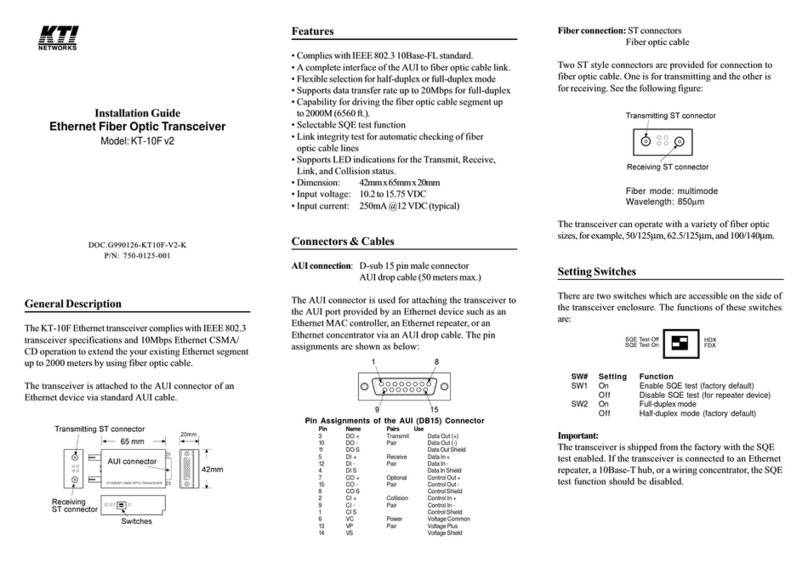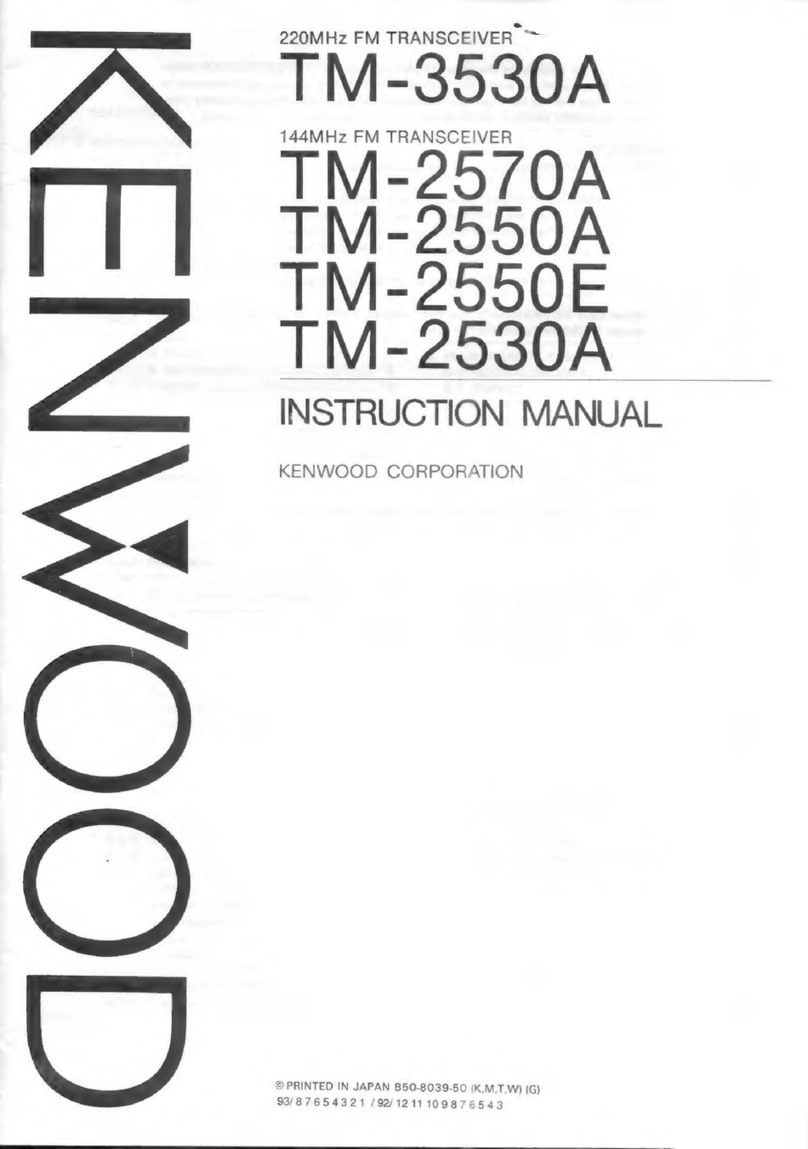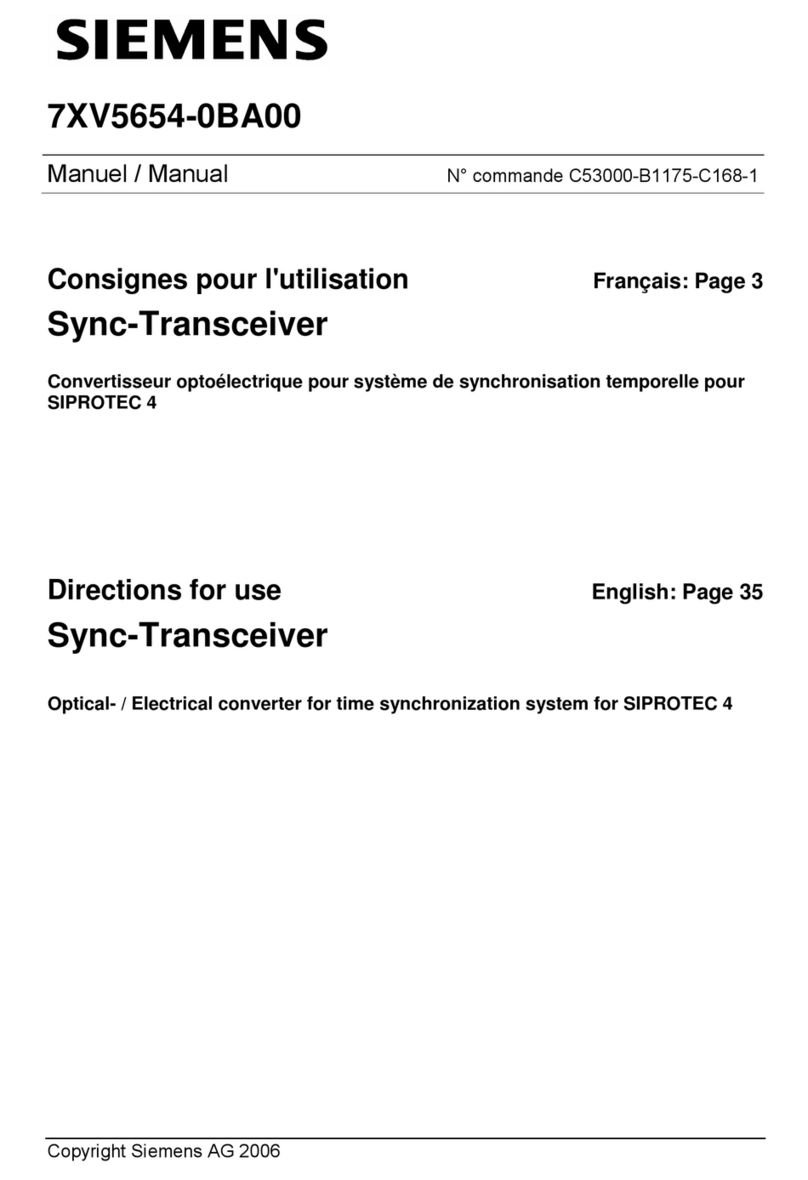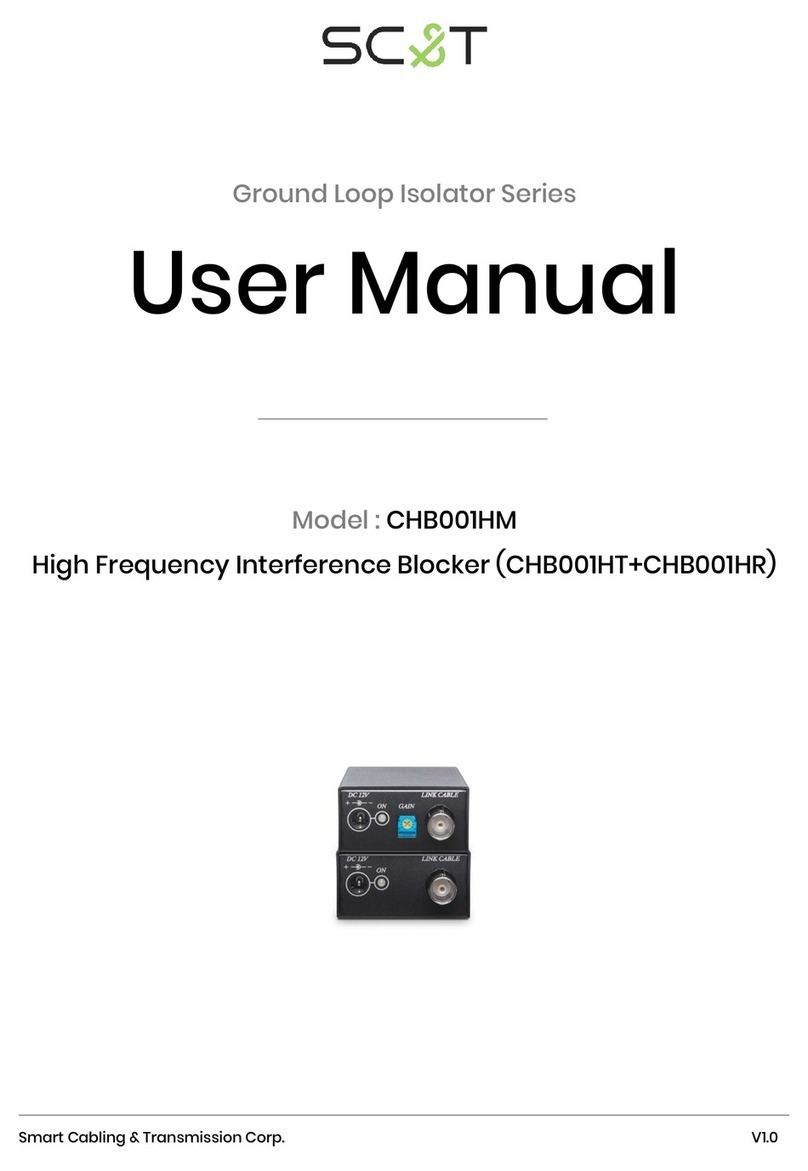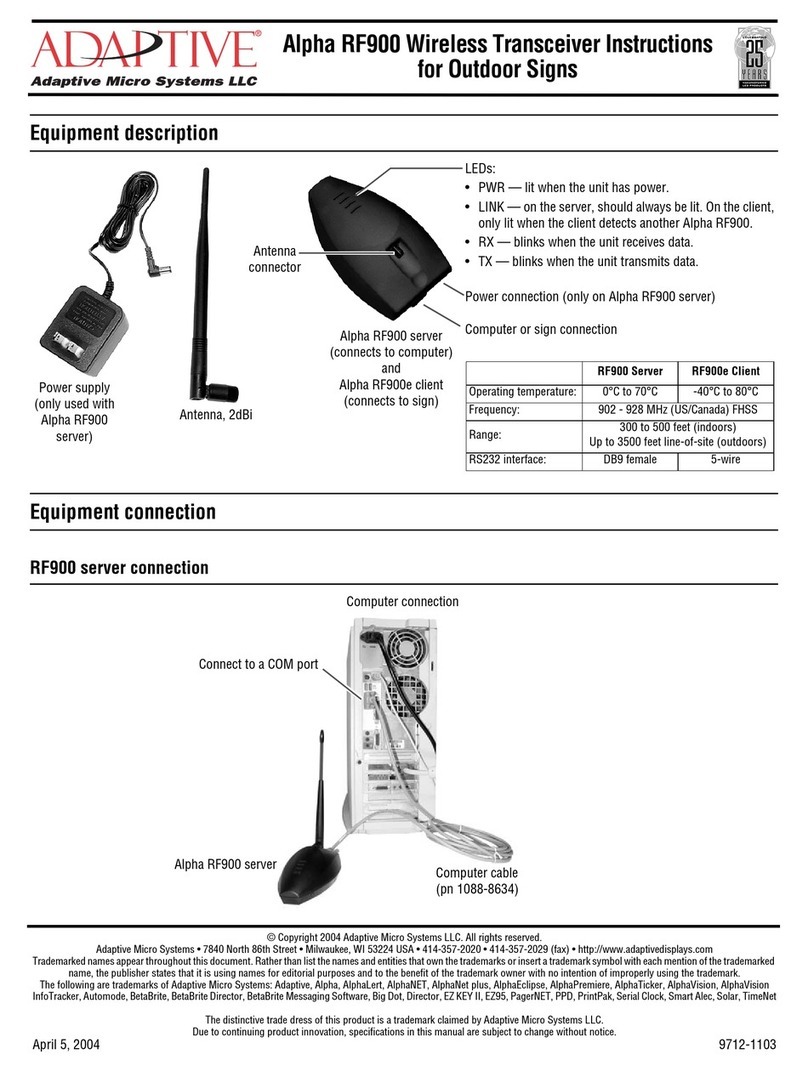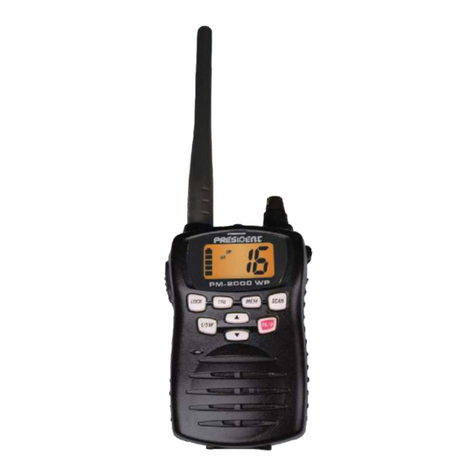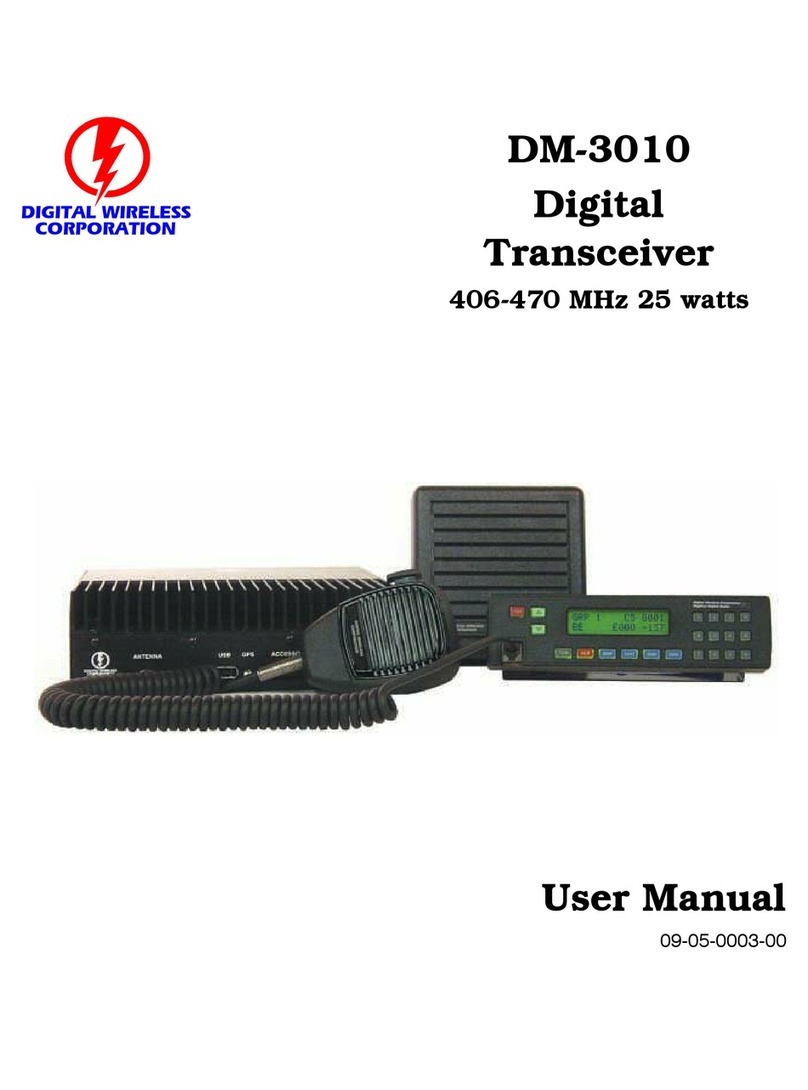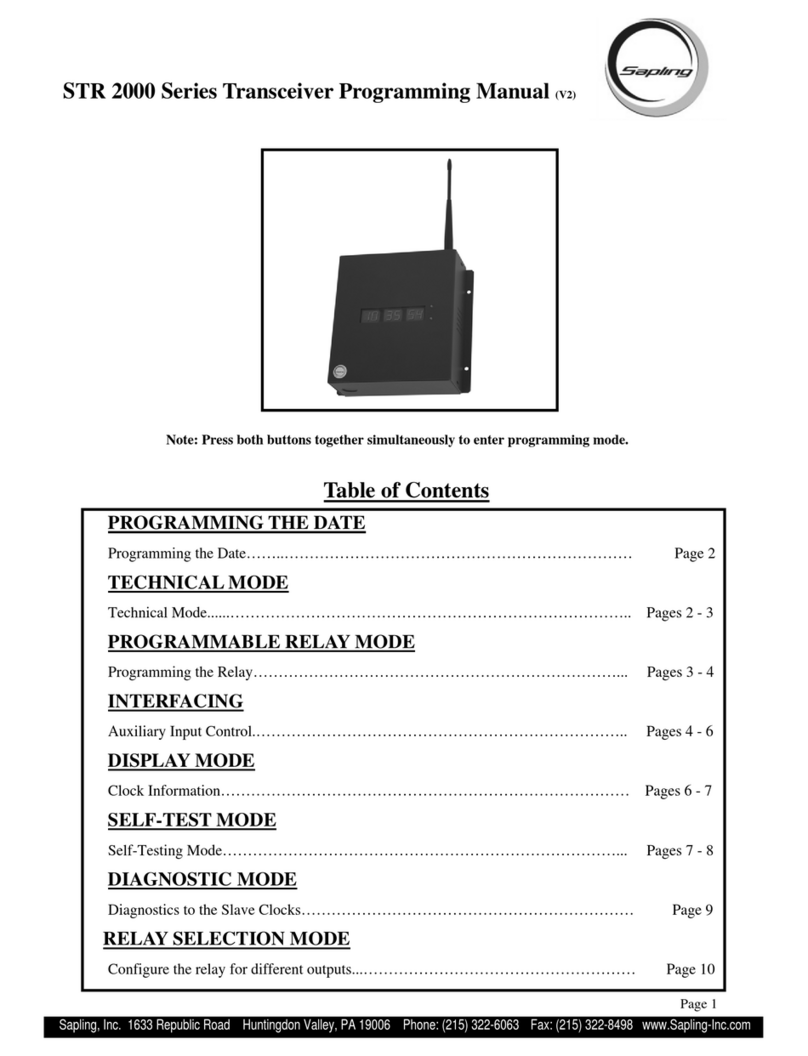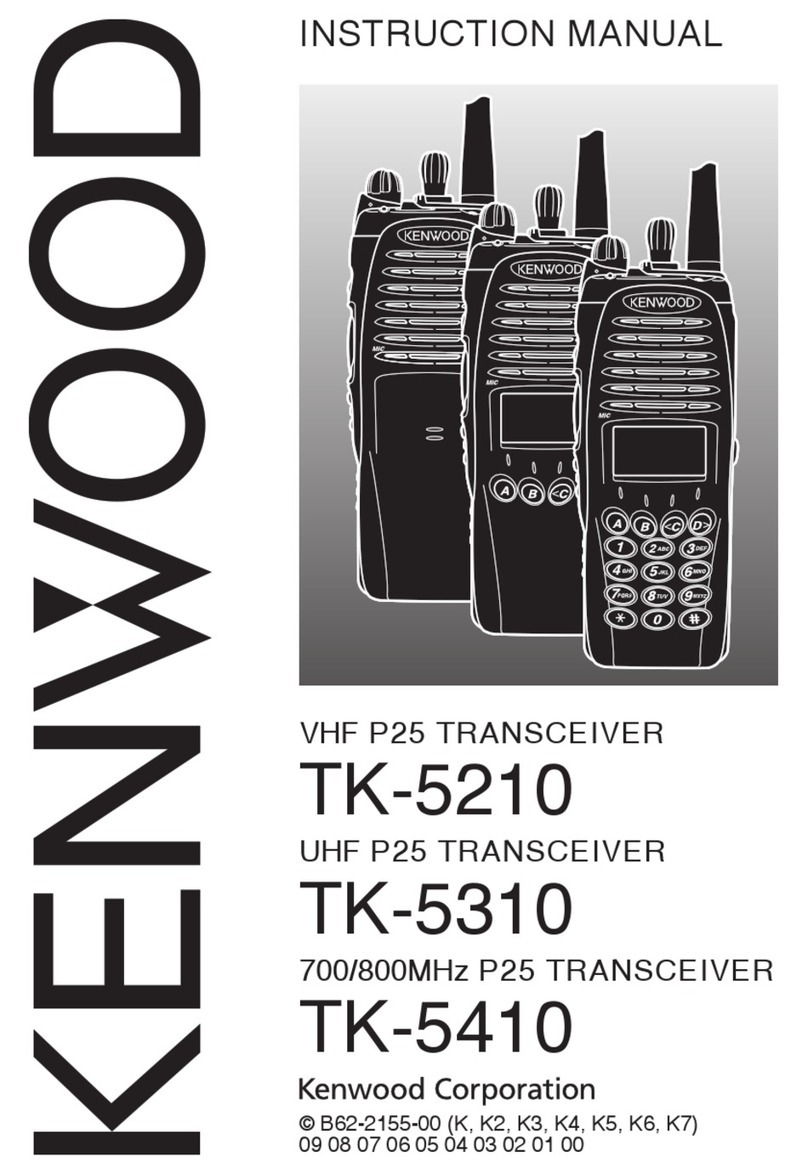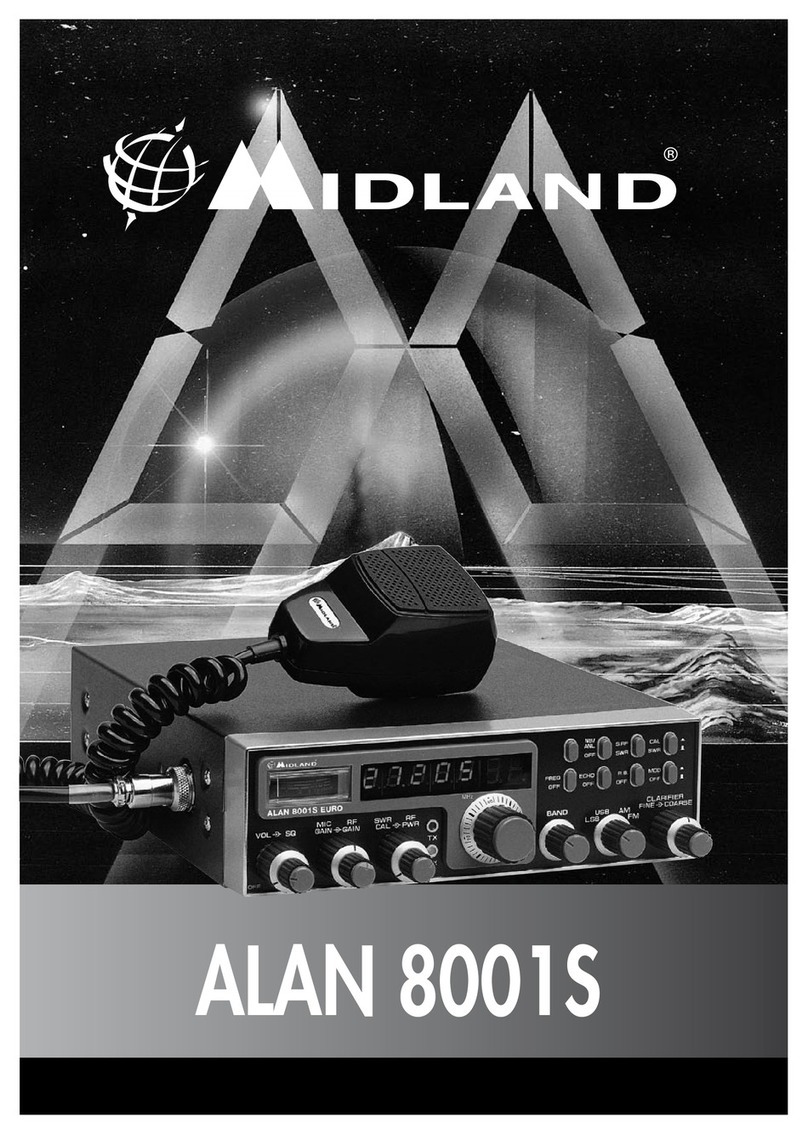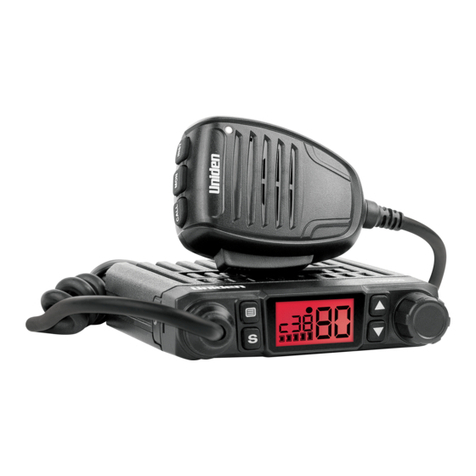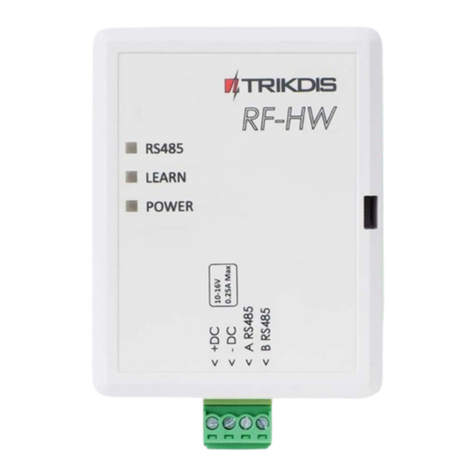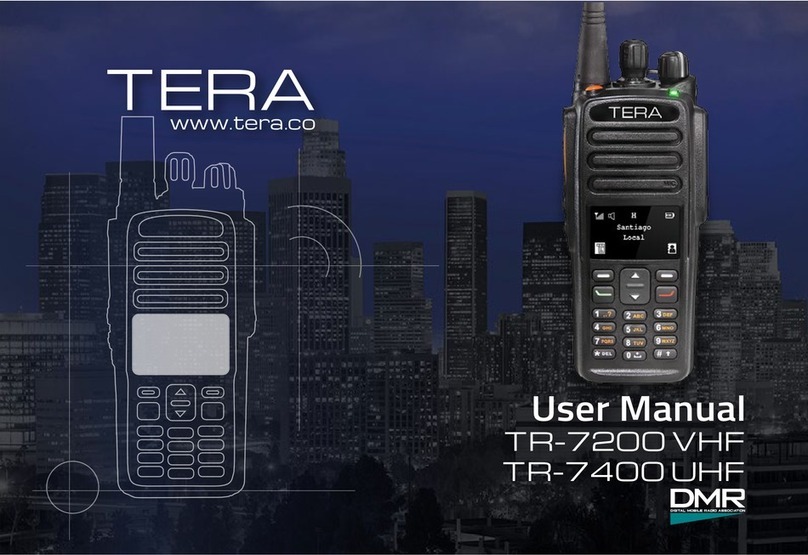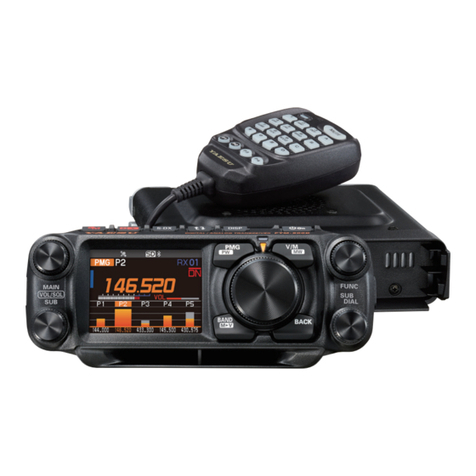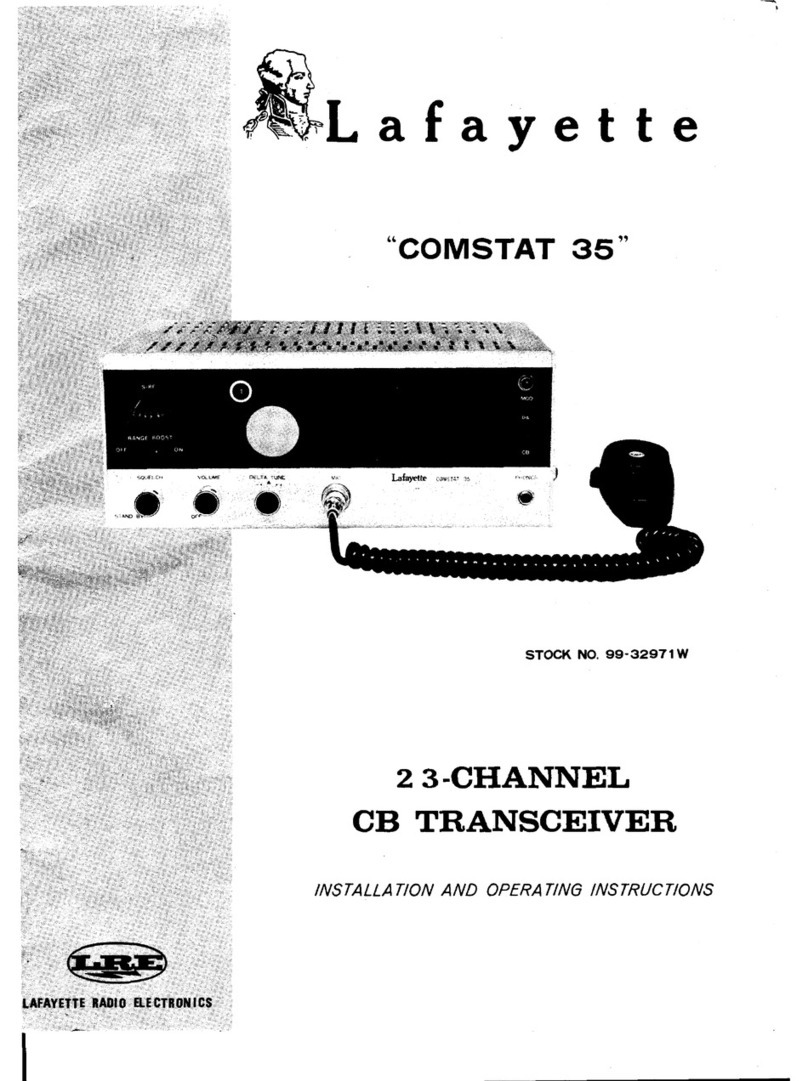Linx TT Series Instruction Manual

TT Series
Remote Control and Sensor
Transceiver
Data Guide

Table of Contents
1 Description
1 Features
2 Ordering Information
2 Electrical Specications
4 Absolute Maximum Ratings
5 Transceiver Timings
6 TRM-xxx-TT Typical Performance Graphs
12 Pin Assignments
12 Pin Descriptions
14 Theory of Operation
15 Module Description
16 Basic Hardware Operation
18 Transceiver Operation
19 Transmit Operation
19 Receive Operation
20 The Pair Process
21 Permissions Mask
21 Acknowledgement
22 Mode Indicator
22 Reset to Factory Default
23 Using the RSSI Line
23 Using the LATCH_EN Line
24 Using the Low Power Features
24 Using the LVL_ADJ Line
26 Receiver Duty Cycle
27 Power Supply Requirements
28 The Command Data Interface
31 Frequency Hopping
32 Usage Guidelines for FCC Compliance
Warning: Linx radio frequency ("RF") products may be
used to control machinery or devices remotely, including machinery
or devices that can cause death, bodily injuries, and/or property
damage if improperly or inadvertently triggered, particularly in industrial
settings or other applications implicating life-safety concerns. No Linx
Technologies product is intended for use in any application without
redundancies where the safety of life or property is at risk.
The customers and users of devices and machinery controlled with
RF products must understand and must use all appropriate safety
procedures in connection with the devices, including without limitation,
using appropriate safety procedures to prevent inadvertent triggering by
the user of the device and using appropriate security codes to prevent
triggering of the remote controlled machine or device by users of other
remote controllers.
Do not use this or any Linx product to trigger an action directly
from the data line or RSSI lines without a protocol or encoder/
decoder to validate the data. Without validation, any signal from
another unrelated transmitter in the environment received by the module
could inadvertently trigger the action.
All RF products are susceptible to RF interference that can prevent
communication. RF products without frequency agility or hopping
implemented are more subject to interference. This module does have
a frequency hopping protocol built in, but the developer should still be
aware of the risk of interference.
Do not use any Linx product over the limits in this data guide.
Excessive voltage or extended operation at the maximum voltage could
cause product failure. Exceeding the reflow temperature profile could
cause product failure which is not immediately evident.
Do not make any physical or electrical modifications to any Linx
product. This will void the warranty and regulatory and UL certifications
and may cause product failure which is not immediately evident.
!

––
1
Description
The TT Series transceiver is designed for
reliable bi-directional, long-range remote
control and sensor applications. It consists of
a highly optimized Frequency Hopping Spread
Spectrum (FHSS) RF transceiver and integrated
remote control transcoder. The FHSS system
allows higher power and, therefore, longer
range than narrowband radios. The transceiver
has obtained modular approval for the United States and Canada.
Eight status lines can be set up in any combination of inputs and outputs
for the transfer of button or contact states. A selectable acknowledgement
indicates that the transmission was successfully received. Operating in the
902 to 928MHz frequency band, the module achieves a typical sensitivity
of –112dBm. The module is capable of generating +12.5dBm transmitter
output power and achieves a range of over 2 miles (3.2 kilometers) line of
site in typical environments with 0dB gain antennas.
Primary settings are hardware-selectable, which eliminates the need for an
external microcontroller or other digital interface. For advanced features,
optional software configuration is provided by a UART interface; however,
no programming is required for basic operation. Housed in a compact
reflow-compatible SMD package, the transceiver requires no external RF
components except an antenna.
Features
• FCC and Canada pre-certified
• 2 mile (3.2km) line of sight range
• Highly efficient power use
• Programmable receiver duty cycle
• No programming/tuning required
• 8 status lines, 2 byte data input
• Bi-directional remote control
• Selectable acknowledgements
• 232 possible addresses
• Serial interface for optional
software operation
TT Series Remote Control
and Sensor Transceiver
Data Guide
Figure 1: Package Dimensions
Revised 2/9/2018
0.131"
(3.33)
0.630"
(16.00)
1.150"
(29.21)
11
Model: TRM-900-TTModel: TRM-900-TT
Lot FX9nnTLot FX9nnT
FCC ID: OJMTRM900TTAFCC ID: OJMTRM900TTA
IC: 5840A-TRM900TTAIC: 5840A-TRM900TTA
32 Additional Testing Requirements
33 Information to the user
34 Product Labeling
34 FCC RF Exposure Statement
34 Antenna Selection
36 Typical Applications
38 Antenna Considerations
39 Helpful Application Notes from Linx
40 Interference Considerations
41 Pad Layout
41 Board Layout Guidelines
43 Microstrip Details
44 Production Guidelines
44 Hand Assembly
44 Automated Assembly
46 General Antenna Rules
48 Common Antenna Styles
50 Regulatory Considerations

–– – –
23
TT Series Transceiver Specifications
Parameter Symbol Min. Typ. Max. Units Notes
Power Supply
Operating Voltage VCC 2.5 5.5 VDC
Peak TX Supply Current ITX
TT @ +12.5dBm 33.9 38.1 mA 1,2
TT @ 0dBm 15.2 18.9 mA 1,2
Average TX Supply Current
TT @ +12.5dBm 21.3 mA 1,2
RX Supply Current IRX 18.8 23 mA 1,2
Standby Current ISBY 200 µA 1,2
Power-Down Current IPDN 0.1 µA 1,2
RF Section
Operating Frequency Band FC902 928 MHz 3
Number of Channels 25 3
Channel Spacing 500 kHz 3
Modulation Rate 45 kbps
Electrical Specications
Ordering Information
Ordering Information
Part Number Description
TRM-900-TT 900MHz TT Series Remote Control and Sensor Transceiver
EVM-900-TT 900MHz TT Series Evaluation Module
EVAL-900-TT TT Series Basic Evaluation Kit
MDEV-900-TT TT Series Master Development System
Transceivers are supplied in tubes of 18 pcs.
Figure 2: Ordering Information
TT Series Transceiver Specifications
Parameter Symbol Min. Typ. Max. Units Notes
Receiver Section
Spurious Emissions Per FCC 15.109
Receiver Sensitivity –110 –111 dBm 5
RSSI Dynamic Range 64 dB
Transmitter Section
Output Power PO−15.5 +12.5 dBm 6
Output Power Control
Range 28 dB
Harmonic Emissions PHPer FCC 15.109
Antenna Port
RF Impedance RI N 50 Ω
Environmental
Operating Temp. Range −40 +85 ºC
Storage Temp. Range −55 +125 ºC
Timing
Module Turn-On Time
Via VCC 8.0 80 ms 4,13
Via POWER_DOWN 8.0 80 ms 4,13
Via Standby 6.8 ms 4
Serial Command Response
Factory Reset/Erase Table 620 ms 8
Write NV Parameter 16 ms 8
Write V/Read/Control 3 ms 8
IU to RU Status High 16 53 ms 7
Channel Dwell Time 12.3 ms
Interface Section
POWER_DOWN, ACK_EN
Logic Low VI L VCC*0.2 VDC
Logic High VI H VCC*0.8 VCC VDC
Input
Logic Low VI L 0.8 VDC 9
Logic Low VI L VCC*0.15 VDC 10
Logic High VI H 2 5.5 9
Logic High VI H VCC*0.25+0.8 4.5 VDC 10

–– – –
45
TT Series Transceiver Specifications
Parameter Symbol Min. Typ. Max. Units Notes
Output
Logic Low VOL 0.6 VDC 11
Logic High VOH VCC–0.7 VCC VDC 12
Certifications
Modular Certifications FCC, Industry Canada
1. Measured at 3.3V VCC
2. Measured at 25ºC
3. Guaranteed by design
4. Characterized but not tested
5. PER = 5%
6. Into a 50-ohm load
7. No RF interference
8. Response time is from end of
command to start of response
9. 4.5 ≤VCC ≤5.5
10. VCC ≤4.5
11. I ≤8mA @ VCC ≥5V; I ≤6mA @ VCC ≥
3.3V; I ≤0.8mA @ VCC ≥2.5V
12. I ≤3.5mA @ VCC ≥5V; I ≤3mA @ VCC ≥
3.3V; I ≤1mA @ VCC ≥2.5V
13. Maximum 80ms if VCC < 2.6V
Figure 3: Electrical Specifications
Absolute Maximum Ratings
Supply Voltage Vcc −0.3 to +5.5 VDC
Any Input or Output Pin −0.3 to VCC + 0.3 VDC
RF Input 0 dBm
Operating Temperature −40 to +85 ºC
Storage Temperature −55 to +125 ºC
Exceeding any of the limits of this section may lead to permanent damage to the device.
Furthermore, extended operation at these maximum ratings may reduce the life of this
device.
Absolute Maximum Ratings
Figure 4: Absolute Maximum Ratings
TX Vcc
TX Sx
TX MODE_IND
RX Sx
ABCDE FGH
RX MODE_IND
AB – TX Power up Response – <80ms
BC – RX Initial Response – 8 to 50ms with no interference
CD – Data Settle – 4 to 8us
EF – Data Update Delay During Active Session – 5 to 25ms
EG – Shutdown Duration – 25 to 342ms
GH – RX MODE_IND Drop – 6 to 8ms
VON
TT Series Transceiver Timings
Item Description Minimum Maximum
AB
TX Response from VCC or POWER_DOWN1,4 8ms
TX Response from Status line while IU in idle212ms
TX Response from Status line while IU / RU idle in RX31ms
BC RX Initial Response 4ms 50ms
CD Data Settle 4µs 8µs
EF Data Update Delay During Active Session 5ms 25ms
EG Shutdown Duration 25ms 342ms
GH RX MODE_IND Drop 6ms 8ms
1. From module off to VCC applied
2. The module is set as an IU only and is in idle pending status line activation
3. The module is set as an IU and RU and is idling in receive mode pending status line
activation or receipt of a valid packet.
4. Maximum 80ms if VCC < 2.6V
Figure 5: TT Series Transceiver Timings
Transceiver Timings
Warning: This product incorporates numerous static-sensitive
components. Always wear an ESD wrist strap and observe proper ESD
handling procedures when working with this device. Failure to observe
this precaution may result in module damage or failure.

–– – –
67
TRM-xxx-TT Typical Performance Graphs
-17.00
-12.00
-7.00
-2.00
3.00
8.00
13.00
0 150 300 450 600 750
900
Output Power (dBm)
LVL_ADJ Resistance (kΩ)
Figure 6: TT Series Transceiver Output Power vs. LVL_ADJ Resistance
14
19
24
29
34
39
-25 -20 -15 -10 -5 0510 15
Supply Current (mA)
TX Output Power (dBm)
85°C
25°C -40°C
Figure 7: TT Series Transceiver Peak Current Consumption vs. Transmitter Output Power at 3.3V Figure 9: TT Series Transceiver Average Current Consumption vs. Transmitter Output Power at 3.3V
12
14
16
18
20
22
24
-25 -20 -15 -10 -5 0510 15
Supply Current (mA)
TX Output Power (dBm)
85°C
25°C
-40°C
14
19
24
29
34
39
-25 -20 -15 -10 -5 0510 15
Supply Current (mA)
TX Output Power (dBm)
85°C
25°C
-40°C
Figure 8: TT Series Transceiver Peak Current Consumption vs. Transmitter Output Power at 5.5V

–– – –
89
13
13.5
14
14.5
15
15.5
16
16.5
2.5 2.7 2.9 3.1 3.3 3.5 3.7 3.9 4.1 4.3 4.5 4.7 4.9 5.1 5.3 5.5
TX ICC (mA)
Supply Voltage (V)
-40°C
25°C
85°C
Figure 12: TT Series Transceiver TX Current Consumption vs. Supply Voltage at 0dBm
19.5
20
20.5
21
21.5
22
22.5
23
2.5 3 3.5 4 4.5 5
5.5
TX Icc (mA)
Supply Voltage (V)
85°C
25°C
-40°C
Figure 11: TT Series Transceiver TX Current Consumption vs. Supply Voltage at Max Power Figure 13: TT Series Transceiver Transmitter Output Power vs. Supply Voltage
11
11.5
12
12.5
13
13.5
2.5 3.3 5.5
Transmitter Output Power (dBm)
Supply Voltage (V)
-40°C
25°C
85°C
Figure 10: TT Series Transceiver Average Current Consumption vs. Transmitter Output Power at 5.5V
12
14
16
18
20
22
24
-25 -20 -15 -10 -5 0510
15
Supply Current (mA)
TX Output Power (dBm)
85°C
25°C
-40°C

–– – –
10 11
0
0.5
1
1.5
2
2.5
3
3.5
-21-31-41-51-61-71-81-91-101-111
RSSI Output Voltage (V)
RF Input Power Level (dBm)
-40°C
25°C
85°C
0.1
0.15
0.2
0.25
0.3
0.35
2.5 3.3 5.5
Standby Icc (mA)
Supply Voltage (V)
-40°C
25°C
85°C
Figure 16: TT Series Transceiver Standby Current Consumption vs. Supply Voltage
Figure 17: TT Series Transceiver RSSI Voltage vs. Input Power
0.1
1
10
0153045607590 105 120 135 150 165 180 195 210 225 240
255
Average Current (mA)
Duty Cycle (s)
2.5VDC
3.0VDC
3.3VDC
5.0VDC
5.5VDC
13.5
14
14.5
15
15.5
16
16.5
17
17.5
2.5 2.8 3.1 3.4 3.7 4 4.3 4.6 4.9 5.2 5.5
RX Icc (mA)
Supply Voltage (V)
-40°C
20°C
85°C
Figure 14: TT Series Transceiver RX Current Consumption vs. Supply Voltage
Figure 15: TT Series Transceiver Average RX Current Consumption vs. Duty Cycle

–– – –
12 13
Pin Assignments
GND
NC
GND GND
NC
NC
GND
NC
NC
NC
NC
NC
GND
NC
GND
ANTENNA
1
2
3
4
5
6
7
83
7
38
39
40
41
42
43
44
S0
S1
GND GND
PAIR
C1
ACK_OUT
C0
CMD_DATA_OUT
LATCH_EN
S2
S3
LVL_ADJ
RESET
ACK_EN
MODE_IND
9
10
11
12
13
14
15
16 29
30
31
32
33
34
35
36
GND
S7
S6 S5
VCC
POWER_DOWN
GND
S4
RSSI
GND
GND
CMD_DATA_IN
17
18
19
20
21
22
23
24
25
26
27
28
Figure 18: TT Series Transceiver Pin Assignments (Top View)
Pin Descriptions
Pin Number Name I/O Description
1, 3, 6, 11,
17, 22, 23,
28, 34, 39,
42, 44
GND — Ground
2, 4, 5, 7, 8,
37, 38, 40, 41 NC — No Electrical Connection. Do not connect
any traces to these lines.
9, 10, 12, 13,
18, 19, 20, 26 S0 - S7 I/O
Status Lines. Each line can be configured
as either an input to register button or
contact closures or as an output to control
application circuitry.
14 LVL_ADJ 1I
Level Adjust. This line sets the transmitter
output power level. Pull high or leave open
for the highest power; connect to GND
through a resistor to lower the power.
Pin Descriptions
Pin Descriptions Continued
Pin Number Name I/O Description
15 LATCH_EN I
If this line is high, then the status line
outputs are latched (a received command
to activate a status line toggles the output
state). If this line is low, then the output lines
are momentary (active for as long as a valid
signal is received) and which are latched.
16 RESET I
Pull low to perform a soft reset of the
module. This line has an internal pull-up to
POWER_DOWN, may be left unconnected
21 RSSI O
Received Signal Strength Indicator. This line
outputs an analog voltage that increases
with the strength of the received signal. It is
updated once a second.
24 POWER_DOWN I
Power Down. Pulling this line low places the
module into a low-power state. The module
is not functional in this state. Pull high for
normal operation. Do not leave floating.
25 VCC — Supply Voltage
27 CMD_DATA_IN I Command Data In. Input line for the serial
interface commands
29 CMD_DATA_OUT O Command Data Out. Output line for the
serial interface commands
30 C0 I
This line sets the input/output direction for
status lines S0-S3. When low, the lines are
outputs; when high they are inputs.
31 ACK_OUT O
This line goes high when the module
receives an acknowledgement message
from another module after sending a control
message.
32 C1 I
This line sets the input/output direction for
status lines S4-S7. When low, the lines are
outputs; when high they are inputs.
33 PAIR I
A high on this line initiates the Pair process,
which causes two units to accept each
other’s transmissions. It is also used with
a special sequence to reset the module to
factory default configuration.
35 MODE_IND O
This line indicates module activity. It can
source enough current to drive a small
LED, causing it to flash. The duration of the
flashes indicates the module’s current state.
36 ACK_EN I
Pull this line high to enable the module to
send an acknowledgement message after a
valid control message has been received.
43 ANTENNA — 50-ohm RF Antenna Port
1. This line has an internal 100kΩpull-up resistor
Figure 19: TT Series Transceiver Pin Descriptions

–– – –
14 15
Theory of Operation
The TT Series transceiver is a low-cost, high-performance synthesized
FSK transceiver. Its exceptional sensitivity results in outstanding range
performance. Figure 20 shows a block diagram for the module.
The TT Series transceiver is designed for operation in the 902 to 928MHz
frequency band. The RF synthesizer contains a VCO and a low-noise
fractional-N PLL. The VCO operates at twice the fundamental frequency
to reduce spurious emissions. The receive and transmit synthesizers
are integrated, enabling them to be automatically configured to achieve
optimum phase noise, modulation quality and settling time.
The transmitter output power is programmable from −15.5dBm to
+12.5dBm with automatic PA ramping to meet transient spurious
specifications. The ramping and frequency deviation are optimized to
deliver the highest performance over a wide range of data rates.
The receiver incorporates highly efficient low-noise amplifiers that provide
up to –112dBm sensitivity. Advanced interference blocking makes the
transceiver extremely robust when in the presence of interference.
A low-power onboard communications processor performs the radio
control and management functions. A control processor performs the
higher level functions and controls the serial and hardware interfaces.
This block also includes voltage translation to allow the internal circuits to
operate at a low voltage to conserve power while enabling the interface to
operate over the full external voltage. This prevents hardware damage and
communication errors due to voltage level differences.
While operation is recommended from 3.3V to 5.0V, the transceiver can
operate down to 2.5V.
RSSI/
LOGAMP
LNAFSK
DEMOD
CDR
AFC
AGC
PROCESSOR
26MHz
OSC
PA RAMP
PROFILE
PA
8-BIT
ADC
LOOP
FILTER
CHARGE
PUMP PFD
DIVIDER
Σ-Δ
MODULATOR
GAUSSIAN
FILTER
f
DEV
DIVIDER
LNA
ANTENNA
GPIO /
INTERFACE
LDO
VCC
PDN
INTERFACE /
VOLTAGE
TRANSLATION
Figure 20: TT Series Transceiver RF Section Block Diagram
Module Description
The TT Series remote control and sensor transceiver module is a
completely integrated RF transceiver and processor. It has two main
modes of operation: hardware and software. Hardware operation is basic
and is suitable for applications like keyfobs where no other processor, PC
or interface is present. Software operation is more advanced and allows for
more features and functionality. This guide focuses on hardware operation
with some references to software operation. Please see Reference Guide
RG-00103: the TT Series Command Data Interface for details on software
operation.
The module has 8 status lines numbered S0 through S7. These can be set
as inputs for buttons or contacts or as outputs to drive application circuitry.
When S0 is taken high on one module S0 goes high on the receiving
module, and so forth. A line that is an input on one side needs to be set as
an output on the other side.
Since this module can act as both transmitter and receiver, terminology and
descriptions are important. This guide uses the term Initiating Unit (IU) to
describe a module that is transmitting commands. Responding Unit (RU) is
used to describe a module that is receiving commands.
The transceiver uses a Frequency Hopping Spread Spectrum (FHSS)
algorithm. This allows for higher output power and longer range than
narrow-band systems while still maintaining regulatory compliance. All
aspects of managing the FHSS operations are automatically handled by the
module.
The TT Series has received modular certification for the FCC in the United
States and Industry Canada when used with an approved antenna. The
module may be placed in an end product without further transmitter
testing, though unintentional radiator testing may be required. Please see
the Usage Guidelines for FCC Compliance section for more details.

–– – –
16 17
Basic Hardware Operation
The following steps describe how to use the TT Series module with
hardware only. Basic application circuits that correspond to these steps are
shown in Figure 21.
1. Set the C0 and C1 lines opposite on both sides.
2. Press the PAIR button on both sides. The MODE_IND LED begins
flashing slowly to indicate that the module is searching for another
module.
3. Once the pairing is complete, the MODE_IND LED flashes quickly to
indicate that the pairing was successful.
4. The modules are now paired and ready for normal use.
5. Pressing a status line button on one module (the IU) activates the
corresponding status line output on the second module (the RU).
6. Taking the ACK_EN line high on the RU causes the module to send an
acknowledgement to the IU. The ACK_OUT line on the IU goes high to
indicate that the acknowledgement has been received. Tying the line
to Vcc causes the module to send an acknowledgement as soon as a
command message is received.
This is suitable for basic remote control or command systems. No
programming is necessary for basic hardware operation. The following
sections describe the functions in more detail and the Typical Applications
section shows additional example schematics for using the modules.
Sensor applications can replace the buttons with triggered outputs from
sensors. A comparator circuit can be used to trigger a line when a sensor
reading crosses a threshold, providing a warning or indication to a user.
The Command Data Interface section describes the more advanced
features that are available with the serial interface.
1
TRM-XXX-TT
NC
2
GND
3
NC
4
NC
5
GND
6
NC
7
S0
9
S1
10
GND
11
S7
18
S6
19
RSSI
21
GND
22 GND23
POWER_DOWN 24
VCC25
S5 26
CMD_DATA_IN27
S2
12
GND
17
S3
13
LVL_ADJ
14
LATCH_EN
15
RESET
16
NC
8
S4
20
GND
GND28
CMD_DATA_OUT29
C0 30
ACK_OUT31
C1 32
PAIR 33
GND34
MODE_IND 35
ACK_EN 36
NC 37
NC 38
GND39
NC 40
NC 41
GND42
ANTENNA 43
GND44
GND
GND
GND
GND
GND
GNDGND
GND
GND
GND
GND
GND
VCC
VCC
GND
100k
100k
100k
100k
GND
91k 1%
GND
GND
GND
GND
VCC
VCC
VCC
VCC
GND
S7
S6
S4
S5
VCC
GND
GND
GND
VCC
VCC
NC
2
GND
3
NC
4
NC
5
GND
6
NC
7
S0
9
S1
10
GND
11
S7
18
S6
19
RSSI
21
GND
22 GND23
POWER_DOWN24
VCC25
S5 26
CMD_DATA_IN 27
S2
12
GND
17
S3
13
LVL_ADJ
14
LATCH_EN
15
RESET
16
NC
8
S4
20
GND
1
GND28
CMD_DATA_OUT29
C0 30
ACK_OUT31
C1 32
PAIR 33
GND34
MODE_IND 35
ACK_EN36
NC 37
NC 38
GND39
NC 40
NC 41
GND42
ANTENNA 43
GND44
TRM-XXX-TT
GND
GND
GND
GND
GND
GNDGND
GND
GND
GND
GND
GND
VCC
VCC
GND
91k 1%
GND
S0
S1
S2
S3
VCC
GND
GND
100k
GND
VCC
100k
100k
100k
GND
GND
GND
GND
VCC
VCC
VCC
VCC
VCC
100k
VCC
VCC
VCC
100k
1
TRM-XXX-TT
NC
2
GND
3
NC
4
NC
5
GND
6
NC
7
S0
9
S1
10
GND
11
S7
18
S6
19
RSSI
21
GND
22 GND23
POWER_DOWN 24
VCC25
S5 26
CMD_DATA_IN27
S2
12
GND
17
S3
13
LVL_ADJ
14
LATCH_EN
15
RESET
16
NC
8
S4
20
GND
GND28
CMD_DATA_OUT29
C0 30
ACK_OUT31
C1 32
PAIR 33
GND34
MODE_IND 35
ACK_EN 36
NC 37
NC 38
GND39
NC 40
NC 41
GND42
ANTENNA 43
GND44
GND
GND
GND
GND
GND
GNDGND
GND
GND
GND
GND
GND
VCC
VCC
GND
100k
100k
100k
100k
GND
91k 1%
GND
GND
GND
GND
VCC
VCC
VCC
VCC
GND
S7
S6
S4
S5
VCC
GND
GND
GND
VCC
VCC
NC
2
GND
3
NC
4
NC
5
GND
6
NC
7
S0
9
S1
10
GND
11
S7
18
S6
19
RSSI
21
GND
22 GND23
POWER_DOWN24
VCC25
S5 26
CMD_DATA_IN 27
S2
12
GND
17
S3
13
LVL_ADJ
14
LATCH_EN
15
RESET
16
NC
8
S4
20
GND
1
GND28
CMD_DATA_OUT29
C0 30
ACK_OUT31
C1 32
PAIR 33
GND34
MODE_IND 35
ACK_EN36
NC 37
NC 38
GND39
NC 40
NC 41
GND42
ANTENNA 43
GND44
TRM-XXX-TT
GND
GND
GND
GND
GND
GN
DG
ND
GND
GND
GND
GND
GND
VCC
VCC
GND
91k 1%
GND
S0
S1
S2
S3
VCC
GND
GND
100k
GND
VCC
100k
100k
100k
GND
GND
GND
GND
VCC
VCC
VCC
VCC
VCC
100k
VCC
VCC
VCC
100k
Figure 21: TT Series Transceiver Basic Application Circuits for Bi-directional Remote Control

–– – –
18 19
Transceiver Operation
The transceiver has two modes of operation: Initiating Unit (IU) that
transmits control messages and Responding Unit (RU) that receives control
messages. If all of the status lines are set as inputs, then the module is set
as an IU only. The module stays in a low power sleep mode until a status
line goes high, starting the Transmit Operation.
If all of the status lines are set as outputs, then the module is set as an RU
only. It stays in Receive Operation looking for a valid transmission from a
paired IU.
A module with both input and output status lines can operate as an IU
and an RU. The module idles in Receive Operation until either a valid
transmission is received or a status line input goes high, initiating the
Transmit operation.
When an input goes high, the transceiver captures the logic state of each
of the status lines. The line states are placed into a packet along with the
local 32-bit address. The IU transmits the packets as it hops among 25 RF
channels.
An RU receives the packet and checks its Paired Module List to see if the
IU has been paired with the module and is authorized to control it. If the
IU’s address is not in the table, then the RU ignores the transmission. If
the address is in the table, then the RU calculates the channel hopping
pattern from the IU’s address and sets its status line outputs according to
the received packet. It then hops along with the IU and updates the states
of its outputs with every packet. Its outputs can be connected to external
circuitry that activates when the lines go high.
The RU can also send an acknowledgement back to the IU. Using the
serial interface the RU can include up to two bytes of custom data with
the acknowledgement, such as sensor data or battery voltage levels.
Using the hardware control, if ACK_EN is high when a valid control packet
is received, the module sends back a simple acknowledgement (ACK). It
sends an Acknowledge with Data (AWD) response when custom data is
programmed into the module using a serial command.
Transmit Operation
Transmit Operation is entered when any of the status line inputs go high.
During Transmit Operation, the MODE_IND line is high. The module
repeatedly transmits control messages containing the local address and
the state of all status lines. Between transmissions the module listens for
acknowledgement messages. If an Acknowledge (ACK) or Acknowledge
with Data (AWD) message is received for the transmitted data, the
ACK_OUT line is asserted for 100ms. The ACK_OUT timing restarts on
each ACK or AWD packet that is received.
The transceiver sends control messages every 12.5ms as long as any
of the status line inputs is high, updating the status line states with
each packet. When all input lines are low, the module starts the shutoff
sequence.
During the shutoff sequence, the transmitter sends at least one packet with
all outputs off. It then continues to transmit data until the current channel
hopping cycle is complete, resulting in balanced channel use. If an input
line is asserted during the shutoff sequence, the transmitter cancels the
shutoff and extends the transmission sequence.
Receive Operation
During Receive Operation, the module waits for a valid control message
from an authorized (paired) transceiver. When a valid message is received,
it locks onto the hopping pattern of the transmitter and asserts the MODE_
IND line. It compares the received status line states to the Permission Mask
for the IU to see if the IU is authorized to activate the lines. The module sets
all authorized outputs to match the received states.
Only status line outputs are affected by received control packets. Received
commands to change an input line have no effect.
The RU then checks the state of the ACK_EN line and transmits an
acknowledgement packet if it is high. It looks for the next valid packet while
maintaining the frequency hopping timing. As long as an RU is receiving
valid commands from a paired IU, it will not respond to any other unit.
Once eight consecutive packets are missed, the RU is logically
disconnected from the IU and waits for the next valid packet from any IU.

–– – –
20 21
The Pair Process
The Pair process enables two transceivers to communicate with each
other. Each transceiver has a local 32-bit address that is transmitted with
every packet. If the address in the received packet is not in the RU’s Paired
Module List, then the transceiver does not respond. Adding devices to
the authorized list is accomplished through the Pair process or by a serial
command. Each module can be paired with up to 40 other modules.
The Pair process is initiated by taking the PAIR line high on both units
to be associated. Activation can either be a momentary pulse (less than
two seconds) or a sustained high input, which can be used to extend the
search and successful pairing display. With a momentary activation, the
search is terminated after 30 seconds. If Pairing is started with a sustained
high input, the search continues as long as the PAIR input is high.
When Pair is activated, the module displays the Pair Search sequence
on the MODE_IND line (Figure 22) and goes into a search mode where it
looks for another module that is also in search mode. It alternates between
transmit and receive, enabling one unit to find the other and respond.
Once bidirectional communication is established, the two units store each
other’s addresses in their Paired Module List with full Permissions Mask
and display the Pair Found sequence on their MODE_IND lines. The Pair
Found sequence is displayed for at least 3 seconds. If the PAIR input is
held high from the beginning of Pairing, the Pair Found display is shown for
as long as PAIR is high.
When Pairing is initiated, the module pairs with the first unit it finds that is
also in Pair Search. If multiple systems are being Paired in the same area,
such as in a production environment, then steps should be taken to ensure
that the correct units are paired with each other.
The Pair process can be canceled by taking PAIR high a second time.
If the address table is full when the PAIR line is raised, the Pair Error
sequence is displayed on the MODE_IND line for 10 seconds and neither
of the Pairing units will store an address. In this case, the module should
either be reset to clear the address table or the serial interface can be used
to remove addresses.
If a paired unit is already in the Paired Module List, then no additional entry
is added though the existing entry’s Permissions Mask may be modified.
Permissions Mask
The TT Series Transceiver has a Permissions Mask that is used to
control which lines an IU is authorized to control. With most systems, if
a transmitter is associated with a receiver then it has full control over the
receiver. With the Permissions Mask, a transmitter can be granted authority
to control only certain receiver outputs. If an IU does not have the authority
to activate a certain line, then the RU does not set it.
As an example, a factory worker can be given a fob that only opens the
door to the factory floor while the CEO has a fob that can also open
the executive offices. The hardware in the fobs is the same, but the
permissions masks are set differently for each fob.
The Pair process always sets the Permission Mask to full access. The mask
can be changed through the serial interface.
Acknowledgement
A responding module is able to send an acknowledgement to the
transmitting module. This allows the initiating module to know that the
responding side received the command.
When the Responding Unit (RU) receives a valid Control Packet, it
checks the state of the ACK_EN line. If it is high the module sends an
Acknowledgement Packet.
If the Initiating Unit (IU) receives an Acknowledgement Packet that has
the same Address and Status Byte as in the Control Packet it originally
sent, then it pulls the ACK_OUT line high. A continuous stream of Control
Packets that triggers a continuous stream of Acknowledgement Packets
keeps the ACK_OUT line high.
Connecting the ACK_EN line to VCC causes the RU to transmit
Acknowledgement Packets as soon as it receives a valid Control Packet.
Alternately this line can be controlled by an external circuit that raises the
line when a specific action has taken place. This confirms to the IU that the
action took place and not just acknowledges receipt of the signal.

–– – –
22 23
Mode Indicator
The Mode Indicator line (MODE_IND) provides feedback about the current
state of the module. This line switches at different rates depending on the
module’s current operation. When an LED is connected to this line it blinks,
providing a visual indication to the user. Figure 22 gives the definitions of
the MODE_IND timings.
Reset to Factory Default
The transceiver is reset to factory default by taking the Pair line high briefly
4 times, then holding Pair high for more than 3 seconds. Each brief interval
must be high 0.1 to 2 seconds and low 0.1 to 2 seconds. (1 second
nominal high / low cycle). The sequence helps prevent accidental resets.
Once the sequence is recognized the MODE_IND line blinks the Reset
Acknowledgement defined in Figure 22 until the PAIR line goes low. After
the input goes low, the configuration is initialized. Factory reset also clears
the Paired Module table but does not change the local address.
If the PAIR input timing doesn’t match the reset sequence timing, the
module reverts to normal operation without a reset or pairing.
MODE_IND Timing
Module Status Display
Transmit Mode Solid ON when transmitting packets.
Receive Mode Solid ON when receiving packets.
Pair Search ON for 100ms, OFF for 900ms while searching for another unit
during the Pair process
Pair Found
ON for 400ms, OFF for 100ms when the transceiver has been
Paired with another transceiver. This is displayed for at least 3
seconds.
Pair Error ON for 100ms, OFF for 100ms when the address table is full and
another unit cannot be added.
Remote Pair Error
ON for 100ms, OFF for 100ms, ON for 100ms OFF for 300ms
when the remote unit’s address table is full and a Pair cannot be
completed.
Pair Canceled ON for 100ms, OFF for 200ms, ON for 100ms when the Pair
process is canceled.
Reset
Acknowledgement
ON for 600ms, OFF for 100ms, ON for 200ms, OFF for 100ms,
ON for 200ms and OFF for 100ms when the reset sequence is
recognized.
Extended Pair
Completed
Solid ON when the pairing operation is completed and waiting for
the PAIR line to go low.
Figure 22: MODE_IND Timing
Using the RSSI Line
The module’s Received Signal Strength Indicator (RSSI) line outputs a
voltage proportional to the incoming signal strength. The RSSI Voltage vs.
Input Power graph in the Typical Performance Graphs section shows the
relationship between the RSSI voltage and the incoming signal power. This
line has a high impedance so an external buffer may be required for some
applications.
The RSSI line updates once a second showing either the strength
of the packet received within the last second or the current channel
measurement. The formula to convert the RSSI voltage to power in dBm is:
PRX = (VRSSI / VCC) * 60 – 105
The RSSI output can be utilized during testing or even as a product feature
to assess interference and channel quality by looking at the RSSI level with
all intended transmitters shut off.
Using the LATCH_EN Line
The LATCH_EN line sets the outputs to either momentary operation or
latched operation. During momentary operation the outputs go high for as
long as control messages are received instructing the module to take the
lines high. As soon as the control messages stop, the outputs go low.
During latched operation, when a signal is received to make a particular
status line high, it will remain high until a separate activation is received to
make it go low. The transmission must stop and the module must time out
before it will register a second transmission and toggle the outputs.
When the LATCH_EN line is high, all of the outputs are latched. A serial
command is available to configure latching of individual lines.
Note: The RSSI levels and dynamic range vary from part to part. It is also
important to remember that the RSSI output indicates the strength of
any in-band RF energy and not necessarily just that from the intended
transmitter; therefore, it should be used only to qualify the presence and
level of a signal. Using RSSI to determine distance or data validity is not
recommended.

–– – –
24 25
Using the Low Power Features
The Power Down (POWER_DOWN) line can be used to completely power
down the transceiver module without the need for an external switch.
This line allows easy control of the transceiver power state from external
components, such as a microcontroller. The module is not functional while
in power down mode.
Using the LVL_ADJ Line
The Level Adjust (LVL_ADJ) line allows the transceiver’s output power to be
easily adjusted for range control or lower power consumption. This is done
by placing a resistor to ground on LVL_ADJ to form a voltage divider with
an internal 100kΩresistor. When the transceiver powers up, the voltage on
this line is measured and the output power level is set accordingly. When
LVL_ADJ is connected to VCC or floating, the output power and current
consumption are the highest. When connected to ground, the output
power and current are the lowest. The power is digitally controlled in 58
steps providing approximately 0.5dB per step. See the Typical Performance
Graphs section (Figure 6) for a graph of the output power vs. LVL_ADJ
resistance.
Even in designs where attenuation is not anticipated, it is a good idea to
place resistor pads connected to LVL_ADJ and ground so that it can be
used if needed. Figure 23 shows the 1% tolerance resistor value that is
needed to set each power level and gives the approximate output power
for each level. The output power levels are approximate and may vary
part-to-part.
Warning: The LVL_ADJ line uses a resistor divider to create a voltage
that determines the output power. Any additional current sourcing or
sinking can change this voltage and result in a different power level. The
power level should be checked to confirm that it is set as expected.
Warning: Pulling any of the module inputs high while in Power Down
can partially activate the module, increasing current consumption
and potentially placing it into an indeterminate state that could lead
to unpredictable operation. Pull all inputs low before pulling POWER_
DOWN low to prevent this issue. Lines that may be hardwired (for
example, the ACK_EN line) can be connected to the POWER_DOWN
line so that they are lowered when POWER_DOWN is lowered.
Power Level vs. Resistor Value
Power
Level
PO
(dBm)
1%
Resistor
Value
Power
Level
PO
(dBm)
1%
Resistor
Value
Power
Level
PO
(dBm)
1%
Resistor
value
57 12.2 Open 38 3.4 154k 19 −5.4 44.2k
56 12.1 750k 37 3.1 143k 18 −5.7 41.2k
55 12.1 649k 36 2.7 133k 17 −6.1 37.4k
54 11.8 576k 35 2.1 127k 16 −6.7 34.8k
53 11.8 510k 34 1.6 118k 15 −7.0 32.4k
52 9.5 453k 33 1.1 111k 14 −7.5 29.4k
51 9.7 412k 32 0.8 105k 13 −7.9 26.7k
50 8.9 347k 31 0.3 97.6k 12 −8.3 24.3k
49 8.3 340k 30 −0.1 91k 11 −8.8 22k
48 8.0 316k 29 −0.6 86.6k 10 −9.3 19.6k
47 7.4 287k 28 −0.9 80.6k 9 −9.1 17.4k
46 6.9 267k 27 −1.4 76.8k 8 −9.6 15.4k
45 6.7 243k 26 −1.8 71.5k 7 −10.2 13.3k
44 6.3 226k 25 −2.3 66.5k 6 −10.8 11.3k
43 5.8 210k 24 −2.8 62k 5 −11.5 9.53k
42 5.3 200k 23 −3.2 57.6k 4 −12.2 7.5k
41 4.8 182k 22 −3.7 54.9k 3 −13.0 5.76k
40 4.3 174k 21 −4.3 51k 2 −13.9 4.02k
39 4.0 165k 20 −4.8 47k 1 −14.5 2.32k
0 −15.7 750
Figure 23: Power Level vs. Resistor Value

–– – –
26 27
Receiver Duty Cycle
The module can be configured to automatically power on and off while
in receive mode. Instead of being powered on all the time looking for
transmissions from an IU, the receiver can wake up, look for data and go
back to sleep for a configurable amount of time. If it wakes up and receives
valid data, then it stays on and goes back to sleep when the data stops.
This significantly reduces the amount of current consumed by the receiver.
It also increases the time from activating the IU to getting a response from
the RU.
The duty cycle is controlled by the Duty Cycle serial command through the
Command Data Interface. DCycle sets the number of seconds between
receiver turn on points as shown in Figure 24.
The module’s average current consumption can be calculated with the
following equation.
TON is fixed at about 0.326 seconds and TSBY = DCycle - TON. The receiver
current (IRX) and standby current (ISBY) vary with supply voltage, but some
typical values are in Figure 26.
Figure 15 shows a graph of the average current consumption vs. duty cycle
for several supply voltages. This graph shows that the average current
consumption can be significantly reduced with even a small duty cycle
value. This is ideal for battery-powered applications that need infrequent
updates or where response time is not critical.
The KeepOn time is used to keep the receiver on after it has completed
some activity. This activity includes completing a transmission and receiving
a valid packet. After KeepOn seconds have elapsed with no transmit or
valid receive activity, the module goes into standby for DCycle seconds.
Please see Reference Guide RG-00103: the TT Series Command Data
Interface for details on configuring the receiver duty cycle.
Power Supply Requirements
The transceiver incorporates a precision
low-dropout regulator which allows operation
over a wide input voltage range. Despite this
regulator, it is still important to provide a supply
that is free of noise. Power supply noise can
significantly affect the module’s performance, so
providing a clean power supply for the module
should be a high priority during design.
A 10Ωresistor in series with the supply followed by a 10µF tantalum
capacitor from Vcc to ground helps in cases where the quality of supply
power is poor (Figure 27). This filter should be placed close to the module’s
supply lines. These values may need to be adjusted depending on the
noise present on the supply line.
+
10Ω
10µF
Vcc IN
Vcc TO
MODULE
Figure 27: Supply Filter
DCycle
TON KeepOn
Activity
ON
Standby
TSBY
ITI TI
DCycle
AVG
ON RX SBY SBY
=×
()
+×
()
Figure 24: Receiver Duty Cycle
Figure 25: Receiver Duty Cycle Average Current Consumption Equation
TT Series Typical Current Consumption
VCC
(VDC) 2.5 3.0 3.3 3.5 4.0 4.5 5.0 5.5
IRX
(mA) 16.5 17.8 18.7 18.8 18.8 18.9 18.9 18.9
ISBY
(mA) 0.0862 0.1471 0.1509 0.1525 0.1569 0.1616 0.1669 0.1737
Figure 26: TT Series Transceiver Typical Current Consumption

–– – –
28 29
The Command Data Interface
The TT Series transceiver has a serial Command Data Interface (CDI)
that offers the option to configure and control the transceiver through
software instead of through hardware. This interface consists of a standard
UART with a serial command set. This allows for fewer connections in
applications controlled by a microcontroller as well as for more control and
advanced features than can be offered through hardware pins alone.
The serial port uses the CMD_DATA_IN and CMD_DATA_OUT lines as a
UART. An automatic baud rate detection system allows the interface to run
at a variable data rate from 9.6kbps to 57.6kbps.
The Command Data Interface has two sets of operators. One is a set
of commands that performs specific tasks and the other is a set of
parameters that are for module configuration and status reporting. These
are shown in Figure 28.
TT Series Transceiver Command Data Interface Reference Guide has full
details on each command. Some key features available with the serial
interface are:
• Configure the module through software instead of setting the hardware
lines.
• Change the output power, providing the ability to lower power
consumption when signal levels are good and extend battery life.
• Individually set which status lines are inputs and outputs.
• Individually set status line outputs to operate as momentary or latched.
• Add or remove specific paired devices.
• Individually set Permission Masks that prevent certain paired devices
from activating certain status line outputs.
• Change the module’s local address for production or tracking purposes
or to replace a lost or broken product.
• Put the module into a low power state to conserve battery power.
• Receive the entire control message serially instead of needing to
monitor individual status lines. Get the IU address for logging access
attempts.
• Receive control messages from unpaired modules, allowing for
expansion of the system beyond the maximum of 40 paired units.
Access control and address validation can be undertaken by an
external processor or PC with more memory than the module.
• Serially configure and control acknowledge messages.
• Send and receive 2 bytes (16 bits) of custom data with each command
message and acknowledge message.
• Serially initiate transmission of control messages instead of triggering
the status line inputs.
• Set interrupts to notify an external processor when specific events
occur, such as receiving a control message.
• Read out the RSSI value for the last received packet and the current
ambient RF level.
• Set the receiver duty cycle for automatically powering on and off to
save battery power.
The serial interface offers a great deal of flexibility for use more complicated
designs. Please see Reference Guide RG-00103: the TT Series Command
Data Interface for details on the CDI. A list of the serial commands is shown
in Figure 28 for reference.

–– – –
30 31
Command Data Interface Commands and Parameters
Command Description
Read Read the current value in volatile memory. If there is no volatile
value, then the non-volatile value is returned.
Write Write a new value to volatile memory.
Read NV Read the value in non-volatile memory.
Program Program a new value to non-volatile memory.
Set Default
Configuration Set all configuration items to their factory default values.
Erase All Addresses Erase all paired addresses from memory.
Transmit Control Data Transmit a control message.
Transmit ACK Transmit an acknowledgement for received data.
Transmit AWD Transmit an Acknowledge With Data (AWD) response with two
bytes of custom data.
Parameter Description
Device Name NULL-terminated string of up to 16 characters that identifies the
module. Read only.
Firmware Version 3 byte firmware version. Read only.
Serial Number 4 byte factory-set serial number. Read only.
Local Address The module’s 32-bit local address.
Status Line I/O Mask Status lines direction (1 = Inputs, 0 = Outputs), LSB = S0, used
when enabled by Control Source
Latch Mask Latching enable for output lines, LSB = S0, used when enabled
by Control Source
TX Power Level TX output power, signed nominal dBm, used when enabled by
Control Source
Control Source Configures the control options.
Message Select Select message types to capture for serial readout
Paired Module
Descriptor
Sets the index number, address and permissions mask of paired
modules.
Duty Cycle Receiver duty cycle control
I/O Lines Read the current state of the status and control lines.
RSSI Read the RSSI of the last packet received and ambient level.
Read only.
LADJ Read the voltage on the LVL_ADJ line. Read only.
Module Status Read the operating status of the module.
Captured Receive
Packet Read the last received packet. Read only.
Interrupt Mask Sets the mask for events to generate a break on CMD_DATA_
OUT.
Event Flags Event flags that are used with the Interrupt Mask.
Figure 28: TT Series Transceiver Command Data Interface Commands and Parameters
Frequency Hopping
The module incorporates a Frequency Hopping Spread Spectrum (FHSS)
algorithm. This provides immunity from narrow-band interference as well as
meets regulatory requirements for higher output power, resulting in longer
range.
The module uses 25 RF channels as shown in Figure 29.
Each channel has a time slot of 12.5ms before the module hops to the next
channel. This equal spacing allows a receiver to hop to the next channel
at the correct time even if a packet is missed. Up to seven consecutive
packets can be missed without losing synchronization.
The hopping pattern is determined from the transmitter’s address. Each
sequence uses all 25 channels, but in different orders. Once a transmission
starts, the module continues through a complete cycle. If the input line
is taken low in the middle of a cycle, the module continues transmitting
through the end of the cycle to ensure balanced use of all channels.
Frequency hopping has several advantages over single channel operation.
Hopping systems are allowed a higher transmitter output power, which
results in longer range and better performance within that range. Since
the transmission is moving among multiple channels, interference on one
channel causes loss on that channel but does not corrupt the entire link.
This improves the reliability of the system.
Channel Frequencies
Channel
Number
Frequency Channel
Number
Frequency Channel
Number
Frequency
1 902.62 10 907.12 18 911.12
2 903.12 11 907.62 19 911.62
3 903.62 12 908.12 20 912.12
4 904.12 13 908.62 21 912.62
5 904.62 14 909.12 22 913.12
6 905.12 15 909.62 23 913.62
7 905.62 16 910.12 24 914.12
8 906.12 17 910.62 25 914.62
9 906.62
Figure 29: TT Series Transceiver RF Channel Frequencies

–– – –
32 33
Usage Guidelines for FCC Compliance
The TT Series module is provided with an FCC and Industry Canada
Modular Certification. This certification shows that the module meets the
requirements of FCC Part 15 and Industry Canada license-exempt RSS
standards for an intentional radiator. The integrator does not need to
conduct any further intentional radiator testing under these rules provided
that the following guidelines are met:
• An approved antenna must be directly coupled to the module’s U.FL
connector through an approved coaxial extension cable.
• Alternate antennas can be used, but may require the integrator to
perform certification testing.
• The module must not be modified in any way. Coupling of external
circuitry must not bypass the provided connectors.
• End product must be externally labeled with “Contains FCC ID:
OJMTRM900TTA / IC: 5840A-TRM900TTA”.
• The end product’s user’s manual must contain an FCC statement
equivalent to that listed on page 33 of this data guide.
• The antenna used for this transceiver must not be co-located or
operating in conjunction with any other antenna or transmitter.
• The integrator must not provide any information to the end-user on
how to install or remove the module from the end-product.
Any changes or modifications not expressly approved by Linx Technologies
could void the user’s authority to operate the equipment.
Additional Testing Requirements
The modules have been tested for compliance as an intentional radiator,
but the integrator is required to perform unintentional radiator testing
on the final product per FCC sections 15.107 and 15.109 and Industry
Canada license-exempt RSS standards. Additional product-specific testing
might be required. Please contact the FCC or Industry Canada regarding
regulatory requirements for the application. Ultimately is it the integrator’s
responsibility to show that their product complies with the regulations
applicable to their product.
Note: The integrator is required to perform unintentional radiator testing
on the final product per FCC sections 15.107 and 15.109 and IC
RSS-GEN.
Information to the user
The following information must be included in the product’s user manual.
FCC / IC NOTICES
This product contains FCC ID: OJMTRM900TTA / IC: 5840A-TRM900TTA
This device complies with Part 15 of the FCC rules and Industry Canada
license-exempt RSS standards. Operation of this device is subject to the
following two conditions:
1. This device may not cause harmful interference, and
2. this device must accept any interference received, including interference that
may cause undesired operation.
This equipment has been tested and found to comply with the limits for a Class
B digital device, pursuant to Part 15 of the FCC Rules. These limits are designed
to provide reasonable protection against harmful interference in a residential
installation. This equipment generates, uses and can radiate radio frequency
energy and, if not installed and used in accordance with the instructions,
may cause harmful interference to radio communications. However, there is
no guarantee that interference will not occur in a particular installation. If this
equipment does cause harmful interference to radio or television reception, which
can be determined by turning the equipment off and on, the user is encouraged
to try to correct the interference by one or more of the following measures:
• Reorient or relocate the receiving antenna.
• Increase the separation between the equipment and receiver.
• Connect the equipment into an outlet on a circuit different from that to which
the receiver is connected.
• Consult the dealer or an experienced radio/TV technician for help.
Any modifications could void the user’s authority to operate the equipment.
Le présent appareil est conforme aux CNR d’Industrie Canada applicables
aux appareils radio exempts de licence. L’exploitation est autorisée aux deux
conditions suivantes:
1. l’appareil ne doit pas produire de brouillage, et
2. ’utilisateur de l’appareil doit accepter tout brouillage radioélectrique subi,
même si le brouillage est susceptible d’en compromettre le fonctionnement.

–– – –
34 35
Le présent émetteur radio (TRM-900-TT) a été approuvé par Industrie
Canada pour fonctionner avec les types d’antenne énumérés la Figure 30
et ayant un gain admissible maximal et l’impédance requise pour chaque
type d’antenne. Les types d’antenne non inclus dans cette liste, ou dont le
gain est supérieur au gain maximal indiqué, sont strictement interdits pour
l’exploitation de l’émetteur.
Product Labeling
The end product must be labeled to meet the FCC and IC product label
requirements. It must have the below or similar text:
Contains FCC ID: OJMTRM900TTA / IC: 5840A-TRM900TTA
The label must be permanently affixed to the product and readily visible to
the user. ‘‘Permanently affixed’’ means that the label is etched, engraved,
stamped, silkscreened, indelibly printed, or otherwise permanently marked
on a permanently attached part of the equipment or on a nameplate of
metal, plastic, or other material fastened to the equipment by welding,
riveting, or a permanent adhesive. The label must be designed to last
the expected lifetime of the equipment in the environment in which the
equipment may be operated and must not be readily detachable.
FCC RF Exposure Statement
To satisfy RF exposure requirements, this device and its antenna must
operate with a separation distance of at least 20cm from all persons and
must not be co-located or operating in conjunction with any other antenna
or transmitter.
Antenna Selection
Under FCC and Industry Canada regulations, this radio transmitter may
only operate using an antenna of a type and maximum (or lesser) gain
approved for the transmitter by the FCC and Industry Canada. To reduce
potential radio interference to other users, the antenna type and its gain
should be so chosen that the equivalent isotropically radiated power
(e.i.r.p.) is not more than that necessary for successful communication.
The TRM-900-TT radio transmitter has been approved by the FCC and
Industry Canada to operate with the antenna types listed in Figure 30 with
the maximum permissible gain and required antenna impedance for each
antenna type indicated. Antenna types not included in this list, having a
gain greater than the maximum gain indicated for that type, are strictly
prohibited for use with this device.
Conformément à la réglementation d’Industrie Canada, le présent émetteur
radio peut fonctionner avec une antenne d’un type et d’un gain maximal
(ou inférieur) approuvé pour l’émetteur par Industrie Canada. Dans le but
de réduire les risques de brouillage radioélectrique à l’intention des autres
utilisateurs, il faut choisir le type d’antenne et son gain de sorte que la
puissance isotrope rayonnée équivalente (p.i.r.e.) ne dépasse pas l’intensité
nécessaire à l’établissement d’une communication satisfaisante.
Figure 30: TT Series Approved Antennas
Antennas / Antennes
Linx Part Number
Référence Linx Type Gain Impedance
Impédance
Tested Antennas
ANT-916-CW-QW ¼ Wave Whip 1.8dBi 50Ω
ANT-916-CW-HW ½ Wave Dipole Helical 1.2dBi 50Ω
ANT-916-PW-LP ¼ Wave Whip 2.4dBi 50Ω
ANT-916-SP Planar 1.4dBi 50Ω
ANT-916-WRT-RPS ½ Wave Dipole Helical –0.1dBidBi 50Ω
ANT-916-CHP ¼ Wave Whip 0.5dBi 50Ω
Antennas of the same type and same or lesser gain
ANT-916-CW-HD ¼ Wave Whip –0.3dBi 50Ω
ANT-916-PW-QW ¼ Wave Whip 1.8dBi 50Ω
ANT-916-CW-RCL ¼ Wave Whip –2.0dBi 50Ω
ANT-916-CW-RH ¼ Wave Whip –1.3dBi 50Ω
ANT-916-CW-HWR-RPS ½ Wave Dipole Helical 1.2dBi 50Ω
ANT-916-PML ½ Wave Dipole Helical –0.4dBi 50Ω
ANT-916-PW-RA ¼ Wave Whip 0dBi 50Ω
ANT-916-USP Planar 0.3dBi 50Ω
Cable Assemblies / Assemblages de Câbles
Linx Part Number
Référence Linx Description
CSI-RSFB-300-UFFR* RP-SMA Bulkhead to U.FL with 300mm cable
CSI-RSFE-300-UFFR* RP-SMA External Mount Bulkhead to U.FL with 300mm cable
* Also available in 100mm and 200mm cable length
This manual suits for next models
6
Table of contents
Other Linx Transceiver manuals
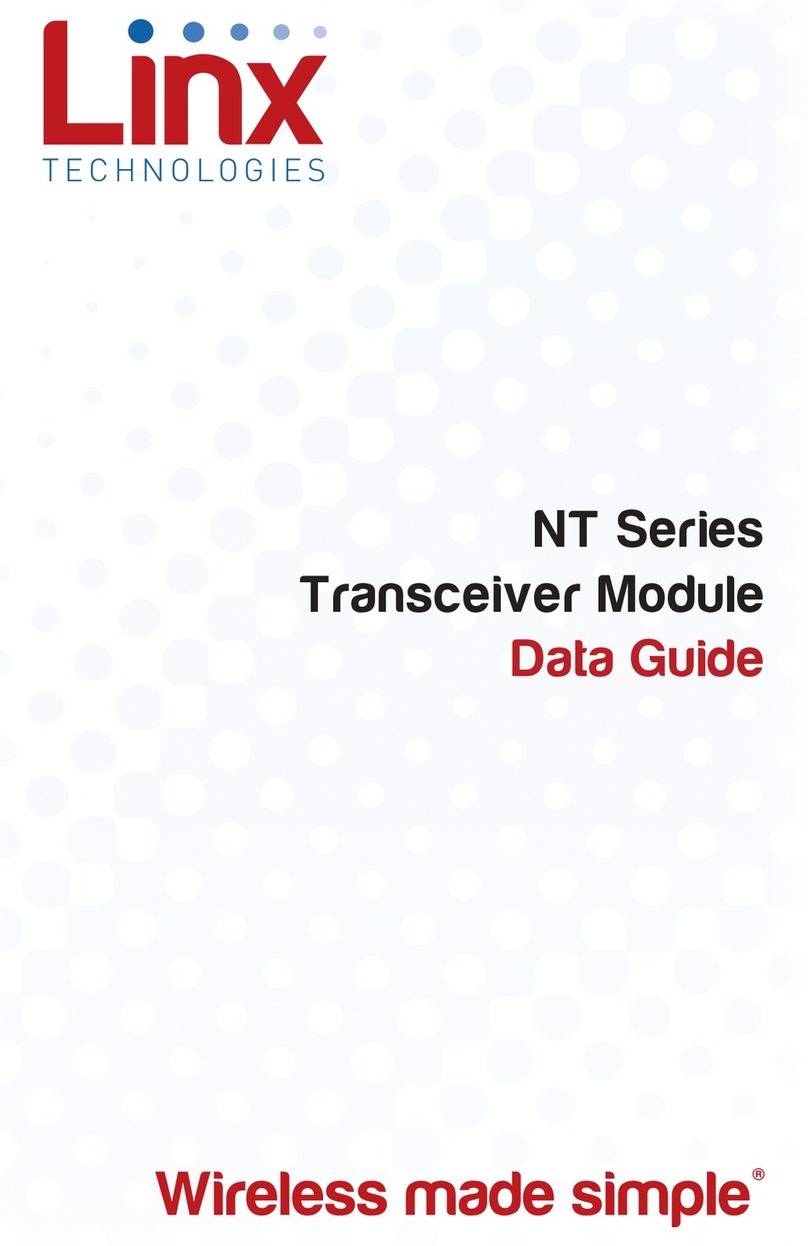
Linx
Linx NT Series Instruction Manual
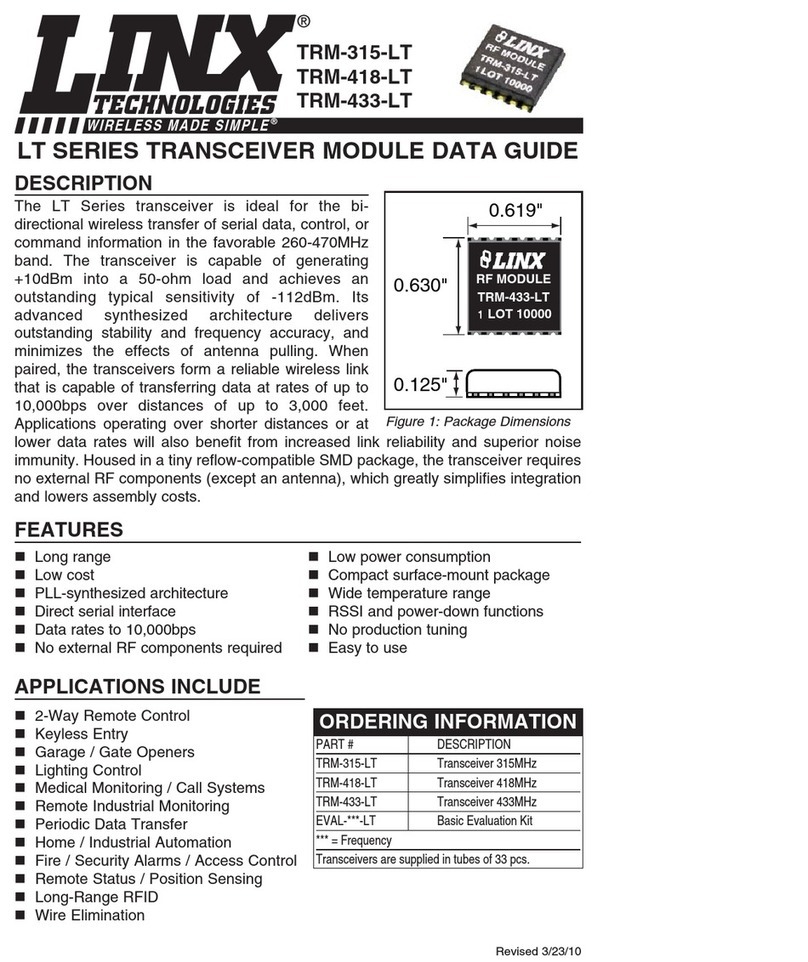
Linx
Linx TRM-315-LT Instruction Manual

Linx
Linx HumRC User manual
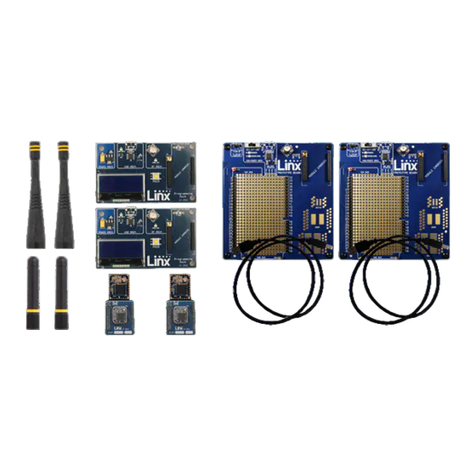
Linx
Linx HumPRO Series Instruction Manual

Linx
Linx HumPRO Series User manual
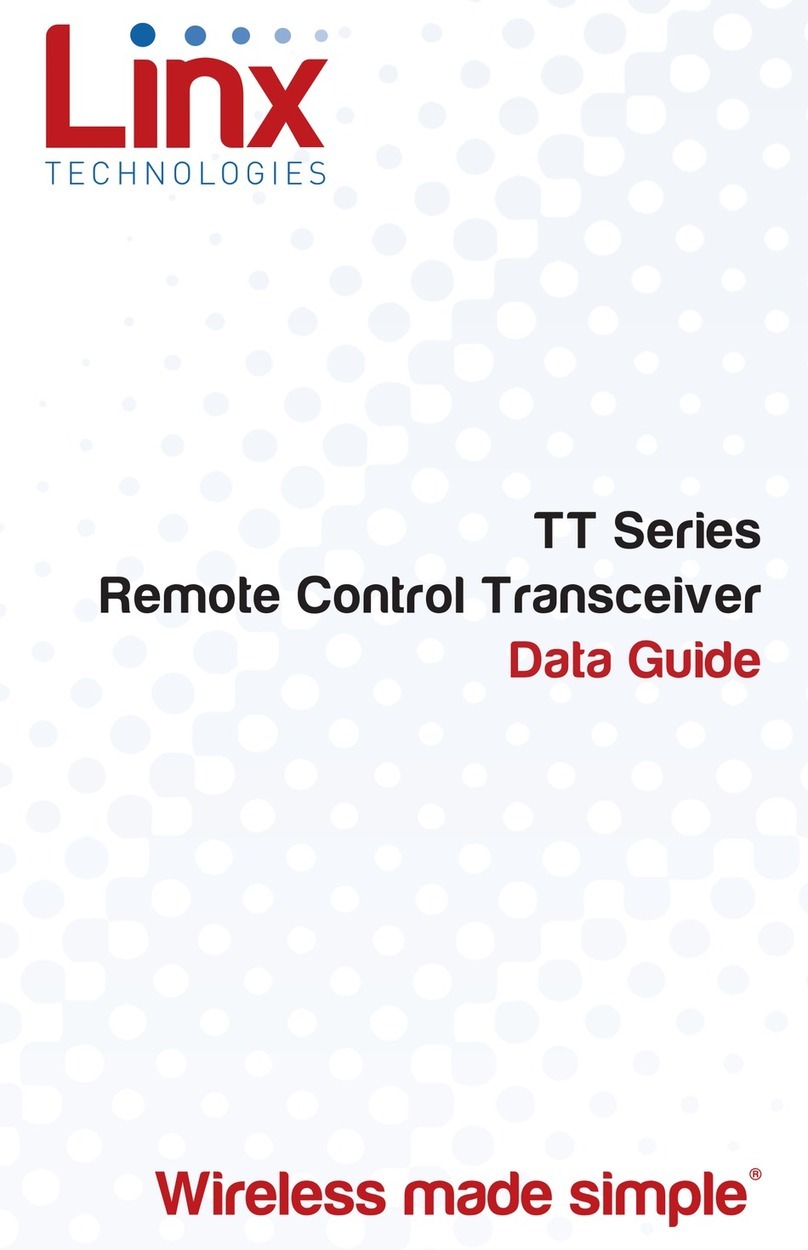
Linx
Linx TRM-900-TT Instruction Manual

Linx
Linx NT Series User manual

Linx
Linx HumDT Series User manual

Linx
Linx HUM-A-900-PRO-UFL Instruction Manual
